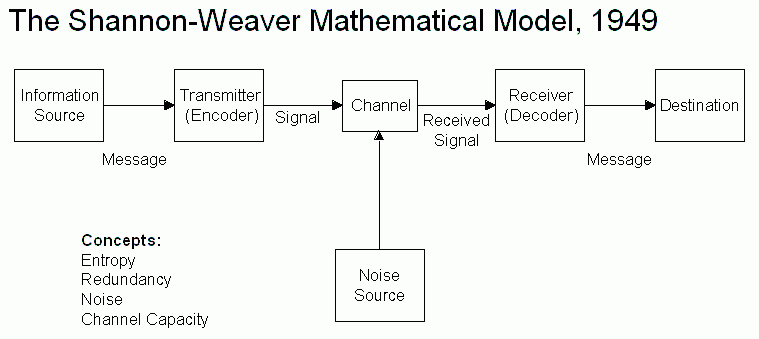Unit 2 – Introduction to Communication Skills Class Notes
Communication models
Models of communication refer to the conceptual model used to explain the human communication process. The first major model for communication came in 1949 by Claude Elwood Shannon and Warren Weaver for Bell Laboratories. Following the basic concept, communication is the process of sending and receiving messages or transferring information from one part (sender) to another (receiver).
Aristotle model
- Oldest model of communication
Five elements

- Speaker -> Speech -> Occasion -> Audience -> Effect
- Speaker is the important in the process of communication as, without him, there’s no message
- Speaker creates audience
- Speech should change according to the audience
- Speech is important for the audience as it changes the attitude of the audience
- The audience is the passive participant – only to listen
- The audience should act according to the speech given by the speaker
- If no effect or impact on the audience, then the communication hasn’t taken place
- The effectiveness of the speech is determined based on the effect on the audience
Lasswell model
- Developed by communication theorist Harold D. Lasswell (1902-1978) in 1948
- Also known as action model or linear model or one way model of communication
- One of the most influential communication models
- Developed to study the media propaganda of countries and businesses at that time
- Talked about the relation between the presentation of facts and how it generates different effects
- The component of effect was made to be more about the outcome of the message

- Who – the communicator or sender or source of the message – Control Analysis
- Says What – the content of the message – Content Analysis
- Is a method of research
- Examine patterns in communication
- to produce increases in the degree of confirmation of hypotheses already
generally presumed to be valid and definitive disconfirmation of hypotheses
already generally presumed to be invalid. - To correct “optical illusions” which may be shared by most specialists.
- To settle disagreements among specialists as the truth value of certain
propositions. - To permit (1) the formulation and (2) the testing of hypotheses …
- In Which Channel – the medium or media – Media Analysis
- Choice of medium depends on the credibility of the content
- Reach out the target audience
- To Whom – the receiver of the message or an audience – Audience Analysis
- Receiver – Audience plays an important role in the process of communication
- Communication comes to an end after the audience receives the message
- With What Effect – the feedback from the receiver to the sender – Effect Analysis
- Concerned with the consequence
- Understand the influence of the message
- Importance of the message can be seen based on the effect
- Control analysis helps the sender to have all the power
- Content analysis is associated with stereotyping and representation of different groups politically It is also related to the purpose or the ulterior motives of the message
- Media analysis represents which medium should be used to exercise maximum power against the receivers
- Audience analysis shows who are the target population to be manipulated or brain-washed
- Effect analysis is done before the process starts. It is used to predict the effect of message over the target population to be exploited
- Oriented towards research
Shannon and Weaver model
- Shannon – Mathematics
- Weaver – Electronic Engineering
- The mathematical theory of communication
- Effective communication between sender and receiver
- Introduce the new factor called noise
- The original model was designed to mirror the functioning of radio and telephone technologies. Their initial model consisted of three primary parts: sender, channel, and receiver.
- The sender was the part of a telephone a person spoke into, the channel was the telephone itself, and the receiver was the part of the phone where one could hear the other person.
- Shannon and Weaver also recognized that often there is static that interferes with one listening to a telephone conversation, which they deemed noise.

The noise could also mean the absence of signal.
In a simple model, often referred to as the transmission model or standard view of communication, information or content (e.g. a message in natural language) is sent in some form (as spoken language) from an emisor/ sender/ encoder to a destination/ receiver/ decoder.
This common conception of communication views communication as a means of sending and receiving information. The strengths of this model are simplicity, generality, and quantifiability.
Social scientists Claude Shannon and Warren Weaver structured this model based on the following elements: An information source, which produces a message.
Without the receiver, no communication
Feedback is very important in this model of communication – influence, effect or consequence
The barrier of noise – communication may not be properly

